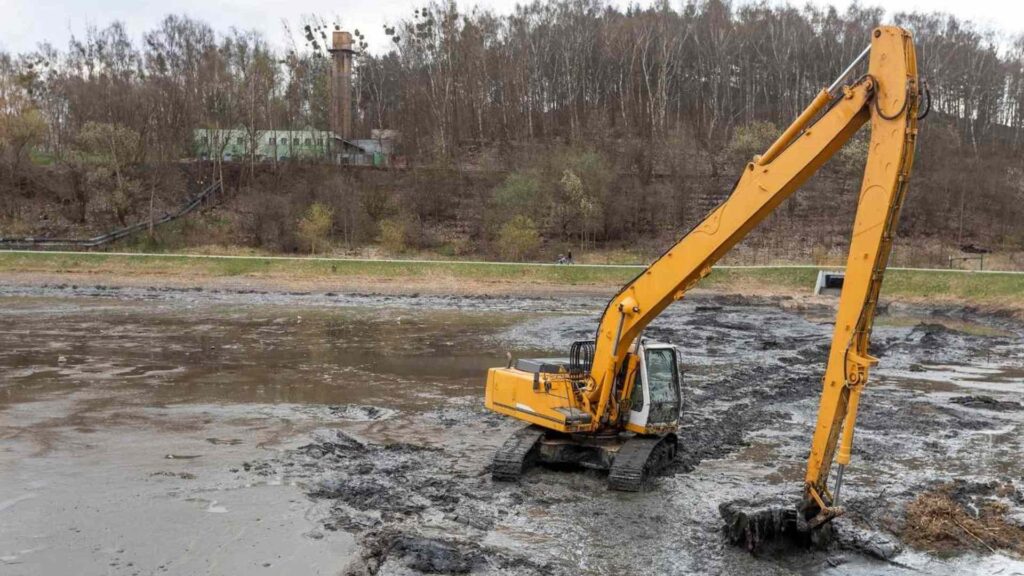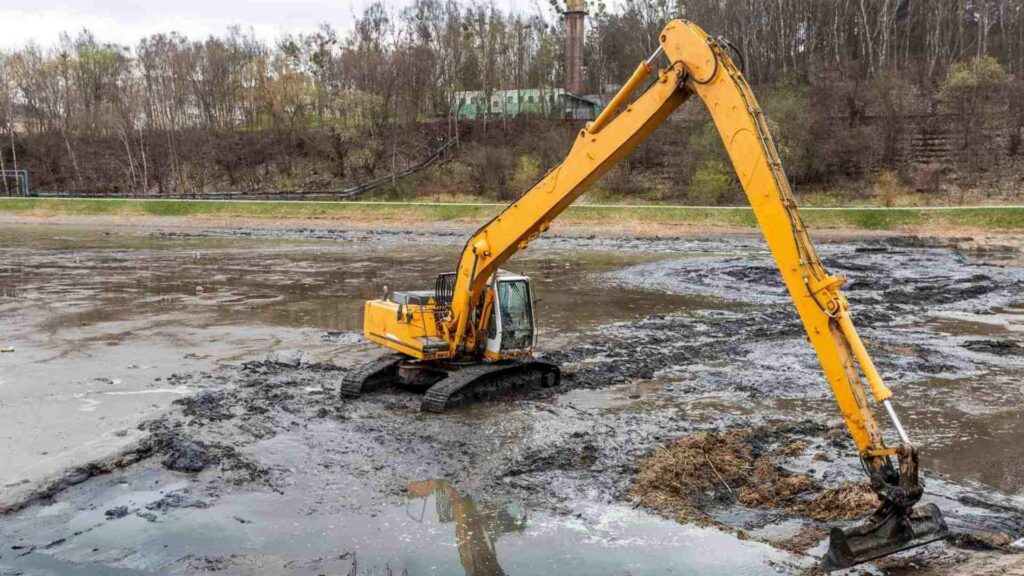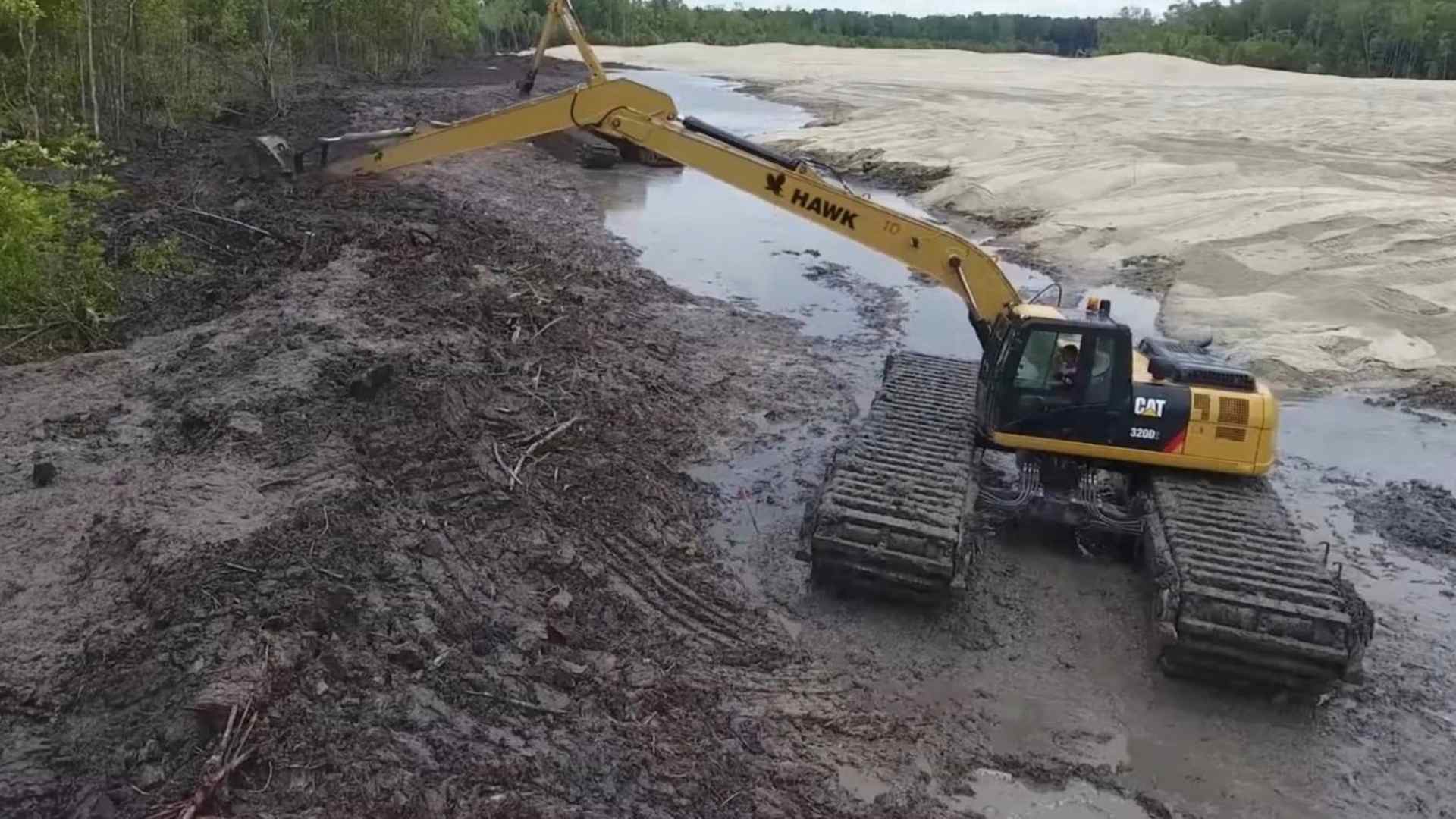Dredging plays a fundamental role in maintaining and restoring water bodies, whether it’s for navigation, flood control, environmental rehabilitation, or infrastructure development. Among the various dredging techniques available today, long reach excavator dredging is gaining widespread adoption due to its precision, flexibility, and adaptability to a variety of water-based and shoreline conditions.
Long reach excavators are specialized machines equipped with extended booms and arms that allow them to perform dredging tasks at greater distances and depths than standard excavators. When paired with tools like an excavator dredge pump or an excavator dredge attachment, these machines become powerful, versatile assets for both inland and coastal projects.
This article explores what long reach excavator dredging is, how it works, and why it’s increasingly favored in modern dredging operations.
What is Long Reach Excavator Dredging?
Long reach excavator dredging refers to the process of removing sediment, debris, or vegetation from water bodies using a hydraulic excavator outfitted with a long boom and arm. Unlike traditional suction or cutter dredgers, which rely on continuous pumping systems, long reach dredging is mechanical, long reach excavator dredging physically lifts material using buckets or excavator dredge attachment.
These excavators are designed to operate from the shore, on barges, or floating platforms, allowing them to reach far into water bodies without needing to move the machine into the water itself. This is particularly useful in locations that are difficult to access or where environmental impact needs to be minimized.
Components That Make Long Reach Excavator Dredging Effective

1. Extended Boom and Arm
The defining feature of a long reach excavator is its significantly extended boom and arm. Depending on the model, reach distances can range from 40 to over 100 feet. This enables the machine to operate from a safe, dry distance while still accessing sediment underwater or far from the shoreline.
2. Excavator Dredge Attachment
A wide range of excavator dredge attachment can be used depending on the task:
- Clamshell buckets for precise sediment removal.
- Rake attachments for clearing aquatic vegetation.
- Hydraulic cutter heads for breaking up compacted material.
These attachments make the excavator a versatile dredging tool capable of handling various materials—from fine silt to heavy clay or rock.
3. Excavator Dredge Pump
To further enhance its capability, an excavator dredge pump can be attached in place of or in combination with a mechanical bucket. This pump allows the excavator to function like a hydraulic dredger, moving slurry through pipelines to distant discharge locations. This hybrid setup blends the reach and control of mechanical dredging with the efficiency of hydraulic material transport.
Where is Long Reach Excavator Dredging Used?
Long reach excavator dredging is suitable for a wide array of applications, including:
- River and canal maintenance – Long Reach Excavator Dredging is used for clearing accumulated sediment that can obstruct water flow or navigation.
- Wetland restoration – Long Reach Excavator Dredging is used for restoring ecological balance by removing excess material or reshaping landforms.
- Coastal defense and beach nourishment – Long Reach Excavator Dredging is also used for depositing or redistributing sand to combat erosion.
- Port and marina dredging – Long Reach Excavator Dredging helps in maintaining berthing depths and removing debris near structures.
- Flood control – Long Reach Excavator Dredging works best for rapidly clearing blocked waterways after storms or landslides.
Long Reach Excavator Dredging versatility makes it a go-to solution for both planned maintenance and emergency response dredging tasks.
Why Use Long Reach Excavator Dredging?

1. Extended Reach for Difficult Access
One of the key advantages of long reach excavators is their ability to operate at significant horizontal distances and depths without needing to be directly over the dredging area. This is especially useful for:
- Dredging narrow rivers, remote canals, or hard-to-reach marshlands.
- Working near bridges, docks, or sensitive shorelines.
- Avoiding the need for building temporary roads or floating platforms.
2. Precision and Minimal Disturbance
With advanced control systems and attachments, long reach excavators provide a high degree of accuracy. This is particularly important for projects in sensitive environments where excess sediment suspension or over-excavation could cause ecological damage.
3. Cost-Effective for Small to Mid-Sized Projects
Long reach dredging is often more economical than deploying large dredging vessels, particularly for localized or seasonal maintenance work. Smaller crews, lower fuel consumption, and faster mobilization contribute to cost savings.
Best Practices for Coastal and Inland Long Reach Dredging Projects
To ensure the success of long reach excavator dredging projects—whether in coastal zones or inland waterways—operators and project planners must follow a set of best practices that balance efficiency, safety, and environmental responsibility.
1. Conduct Comprehensive Site Assessment
Before beginning Long Reach Excavator Dredging, it’s vital to analyze the site’s:
- Bathymetry – Understand water depth and bottom contours.
- Sediment composition – Identify the types of material to be dredged (e.g., silt, sand, clay, organic matter).
- Flow dynamics – Examine tidal influence, current speed, and seasonal changes.
- Ecological sensitivity – Locate aquatic habitats, nesting grounds, or protected species.
These data help inform equipment choice, project scope, and necessary environmental safeguards.
2. Select the Right Excavator and excavator dredge attachment
The type and size of excavator should match the site requirements in terms of reach, lifting capacity, and ground conditions. Equally important is the selection of the correct excavator dredge attachment, such as:
- Clamshell buckets – For deep, precise digging in confined spaces.
- Rake buckets – To remove vegetation or debris.
- Hydraulic cutter heads – For breaking up compacted materials.
- Excavator dredge pump – For transferring slurry through pipelines to a designated discharge point.
Having the right attachment ensures optimal performance, reduces downtime, and improves project outcomes.
3. Choose Appropriate Mounting and Positioning
Depending on site conditions, long reach excavators may be mounted on:
- Tracked undercarriages – For working from stable riverbanks or shorelines.
- Amphibious pontoons – For marshy, shallow water zones.
- Barges or floating platforms – For deepwater dredging or coastal areas.
Proper anchoring and counterweight balancing are essential when operating from floating platforms to prevent tipping or instability.
4. Implement Environmental Protection Measures
To minimize environmental impact during Long Reach Excavator Dredging operations:
- Use silt curtains or turbidity barriers in ecologically sensitive zones.
- Avoid dredging during breeding or migratory periods for aquatic species.
- Monitor turbidity, pH, and other water quality parameters in real time.
- Test sediment for contaminants and follow local disposal regulations.
When using an excavator dredge pump, take care to direct sediment slurry to approved disposal or reclamation sites to prevent secondary pollution.
5. Optimize with GPS and Digital Controls
Modern long reach excavators can be outfitted with:
- GPS-based positioning systems – For precise excavation mapping.
- Sonar sensors – To monitor real-time dredging depth.
- Digital telemetry – For tracking volume, productivity, and maintenance needs.
These technologies enhance efficiency, reduce rework, and allow for better documentation and regulatory compliance.
6. Prioritize Operator Safety and Training
Operators must be trained in long reach operation dynamics, especially when handling:
- Unbalanced loads at full reach.
- Hydraulic failures or attachment malfunctions.
- Emergency procedures on water-based platforms.
Regular inspection of structural components, hydraulic systems, and excavator dredge attachment ensures safety and extends equipment life.
Advantages of Long Reach Excavator Dredging
1. Precision and Control
Long Reach Excavator Dredging allows for accurate control of excavation depth and location, making it ideal for work in environmentally sensitive areas.
2. Extended Accessibility
With Long Reach Excavator Dredging, the excavator can perform tasks that would otherwise require constructing temporary platforms or floating equipment.
3. Lower Turbidity
Compared to suction dredging, Long Reach Excavator Dredging methods create less disturbance in the water column—minimizing turbidity and protecting aquatic habitats.
4. Cost Efficiency
For smaller to medium-sized dredging jobs, long reach excavators offer a cost-effective alternative to deploying large dredging vessels.
5. Tool Flexibility
With the right excavator dredge attachment, a single machine can handle digging, pumping, vegetation clearing, and grading.
Key Benefits of Long Reach Excavator Dredging
1. Extended Reach and Accessibility
The most obvious benefit of long reach excavator dredging is the ability to access areas that are otherwise unreachable. With boom lengths often extending 40 to over 100 feet, these excavators can operate from a secure position while reaching far into a water body. This minimizes the need for temporary roads, bridges, or floating platforms, thereby reducing project setup time and cost.
2. Enhanced Precision and Control
Long reach excavator dredging allows operators to have precise control over dredging depth, material placement, and movement. This is especially valuable in sensitive environments like wetlands or near critical infrastructure, where unintentional damage or over-dredging can cause long-term harm.
Using attachments like GPS-guided control systems and sonar-based depth sensors, long reach excavators can target specific areas with a high level of accuracy, making them ideal for maintenance dredging, canal reshaping, or creating detailed aquatic contours.
3. Tool Flexibility and Versatility
A major advantage of this dredging method is the ability to customize the equipment using various excavator dredge attachments. Depending on the project requirements, the operator can easily switch between:
- Clamshell buckets – for precision digging and deeper sediment removal.
- Rake attachments – for clearing aquatic vegetation or debris.
- Hydraulic cutter heads – to dislodge compacted materials.
- Excavator dredge pumps – for transporting sediment through pipelines.
This flexibility makes long reach excavators a one-stop solution for a wide range of dredging needs without changing core equipment.
4. Cost-Effective Operation
Compared to traditional dredgers or specialized dredging vessels, long reach excavators with excavator dredge pump and excavator dredge attachment are significantly more cost-effective, particularly for small- and medium-scale projects. They require fewer crew members, have lower fuel consumption, and involve reduced mobilization costs. In many cases, a single excavator can complete the job without needing support vessels, thus saving both time and resources.
5. Reduced Environmental Impact
Long reach excavator dredging with excavator dredge pump and excavator dredge attachment produces less water turbidity than suction dredging methods. This is important for projects near aquatic habitats, drinking water sources, or environmentally protected zones. When equipped with the appropriate excavator dredge pump, sediment can be efficiently transported away without stirring up large volumes of water, helping to preserve water quality and aquatic life.
6. Rapid Deployment and Mobility
Long reach excavators are easy to deploy and relocate, making them highly effective for emergency situations such as flood response, landslide debris removal, or post-storm waterway clearance. Whether mounted on land, barges, or amphibious platforms, they can be adapted quickly to suit project-specific conditions.
Applications of Long Reach Excavator Dredging
The adaptability and efficiency of long reach excavators allow them to be used across a broad range of applications in both coastal and inland environments.
1. River and Canal Maintenance
Over time, rivers and canals accumulate sediment, trash, and vegetation that obstruct flow and reduce navigability. Long reach dredging is commonly used to:
- Remove silt, sand, and organic matter from riverbeds.
- Restore flow capacity and prevent flooding.
- Maintain irrigation channels in agricultural zones.
Using a combination of mechanical buckets with excavator dredge attachment and excavator dredge pumps, sediment can be removed and transferred to remote containment areas for dewatering or reuse.
2. Coastal Erosion Control and Beach Replenishment
In coastal zones, long Reach Excavator Dredging support projects aimed at:
- Reinforcing sea defenses and revetments.
- Redistributing sand for beach nourishment.
- Placing large rocks or geotextile tubes to combat erosion.
Mounted on floating barges, excavators can deposit materials precisely along shorelines without affecting marine habitats.
3. Wetland and Habitat Restoration
Wetlands require careful dredging to preserve or restore their ecological balance. Long reach excavators are ideal for such tasks because they offer:
- Minimal disruption to surrounding areas.
- Precision in shaping landforms or restoring channels.
- Gentle removal of invasive species or dead vegetation.
Attachments like rake buckets and clamshells allow for non-invasive excavation in ecologically sensitive zones.
4. Port, Jetty, and Marina Maintenance
Harbors and small ports often face sedimentation issues near structures. Long reach dredging can help:
- Maintain navigable depth near docks and piers.
- Dredge around pilings and pontoons with precision.
- Perform construction or maintenance without deploying full-scale dredging vessels.
When equipped with a high-efficiency excavator dredge attachment, operators can manage both excavation and sediment relocation without interrupting port operations.
5. Disaster and Emergency Response
Floods, landslides, and storms frequently clog drainage systems and riverways with debris. Long reach excavators with excavator dredge attachment are often deployed to:
- Remove blockages from water channels.
- Create temporary flood diversion canals.
- Clear urban drainage systems in post-disaster recovery zones.
Their mobility and quick setup make them an essential tool for disaster mitigation and rapid environmental response.
Efficient and Eco-Friendly Dredging with Long Reach Excavators
Long reach excavator dredging has become an essential method in the dredging industry, offering a practical, precise, and adaptable solution for a wide range of projects. Whether it’s maintaining rivers, restoring wetlands, or reinforcing coastlines, the combination of extended reach, specialized attachments, and the optional excavator dredge pump provides unmatched flexibility and control.
As environmental regulations tighten and the need for sustainable dredging grows, long reach excavators, equipped with the right tools, will continue to serve as an indispensable part of modern dredging operations.
By choosing the correct excavator dredge attachment and deploying smartly planned equipment, project managers can deliver effective results while minimizing environmental and operational impacts.
